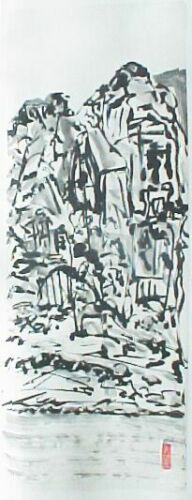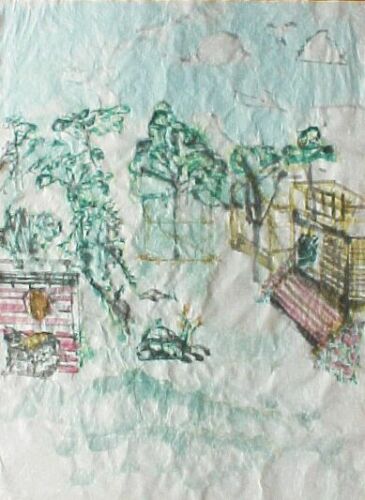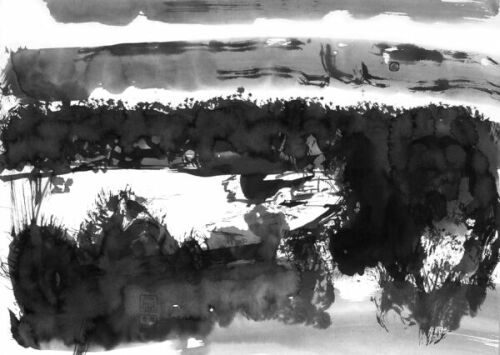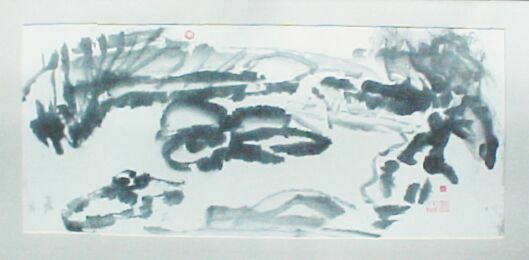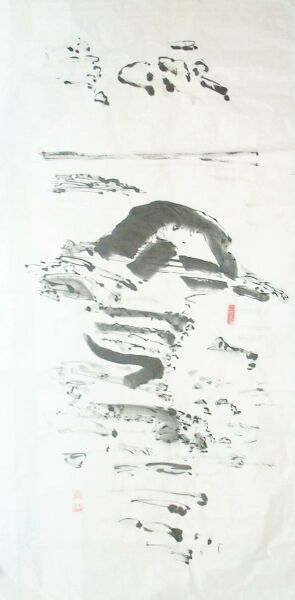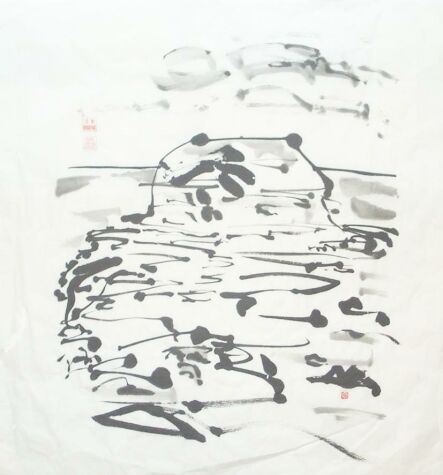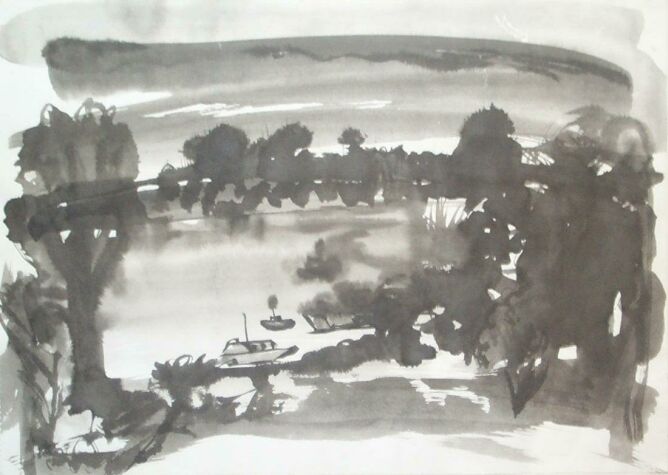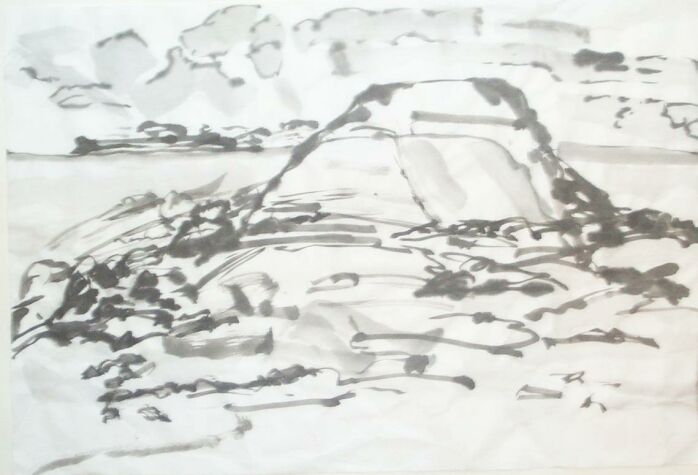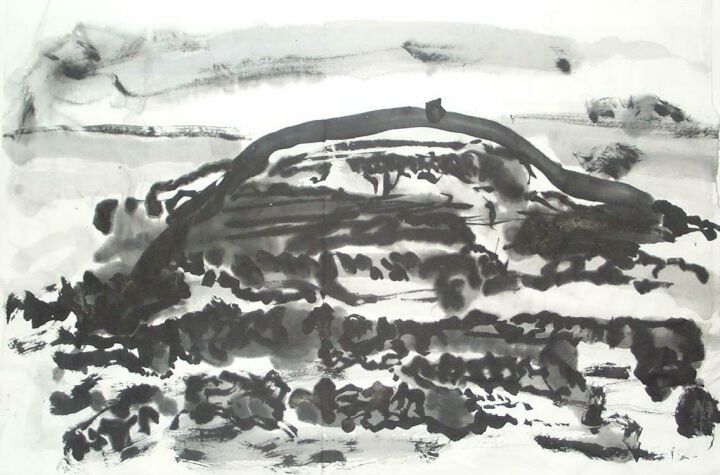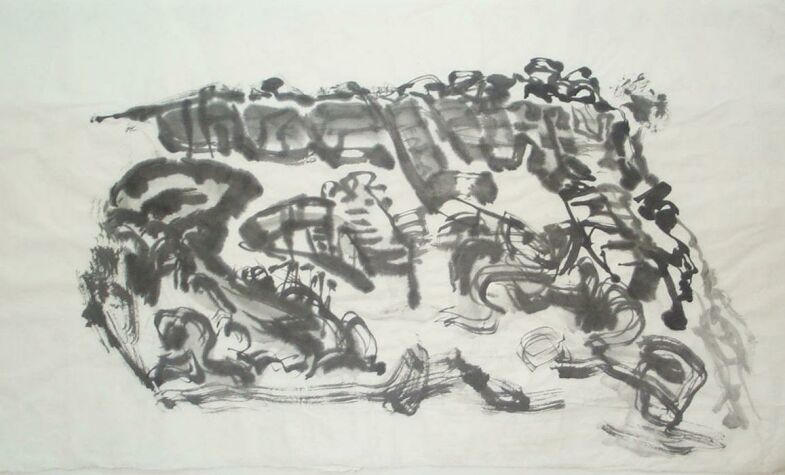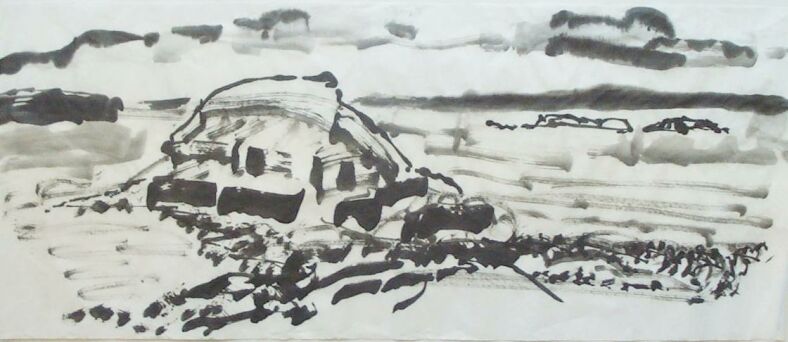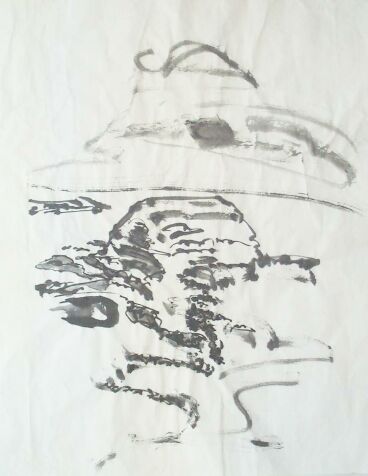*Chan Academy is a registered business name of the Buddhist Discussion Centre (Upwey) Ltd.
A.C.N. 005 701 806 A.B.N. 42 611 496 488
33 Brooking Street, Upwey, Victoria 3158, Australia
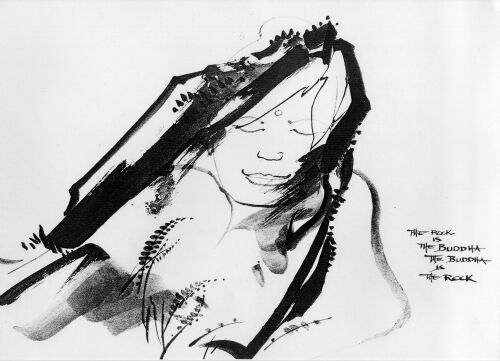
"Canvassing the Four Seasons" Exhibition
An Auction of
Chan Paintings by Master John D. Hughes
will be held on 9 September 2002 at 2:00pm
at 33 Brooking Street, Upwey, Victoria 3158, Australia
Preview
Catalogue of Paintings
This catalogue was written and edited by John D. Hughes.
The originals of the exhibition will be on display from 12.00pm to 1.55pm on Monday 9 September 2002 prior to the auction to be held at 2.00pm.
Prospective buyers may see the pieces by appointment.
For further appointment details please contact Julian Bamford, B.A. App. Rec. on 0400 267 330 or (03) 9754 3334.
Cover Design: "The Rock is The Buddha and The Buddha is The Rock" painted with Chinese ink on paper by the Artist Andre Sollier
Introduction to Canvassing the Four Seasons.
Welcome to "Canvassing the Four Seasons" exhibition.
For our cover, we have reproduced the painting "The Rock is the Buddha The Buddha is The Rock" by Andre Sollier 2 March 2002.
Our Chan Academy awarded Andre Sollier our Kalyanamitta Award on the day he presented us with this piece. It reminded practitioners to practice the painting of rocks by way of the brush. May our students practice this piece for the rest of their lives.
The underlying theme of the exhibition is the fleeting changes of the seasons, which bring about the awareness of the rejuvenation of nature, and the impermanence of life.
The quality of the reproductions here are not exact. The thumb nail sketches produced in house were taken with a digital camera and digitally manipulated. They are low resolution so much of the sharpness of brush work, black ink and shading nuances in the originals have been lost.
The truth expressed in our present pieces is as if the landscapes were half-remembered by the artist from a series of previous visits.
The ancient gods of the mountains invite the artist to visit and record. They help gather the energy needed to perform with the brush at that place.
Sometimes the mountains are under ice or water. These agents leave their impression.
If you glance carelessly at the Coles Bay pieces you may sense the nascent presence of the ice and snow.
Some pebbles taken from the area have healing qualities because of stored water element. There are health benefits for the artist who sits in the area.
Although painted several years apart over four seasons they give the impression that they were painted consecutively in the same hour.
Yet each piece stands alone, timeless and complete.
It is as if rebirth consciousness of the artist appeared at the completion of the last stroke of one piece, and continued into the brushstroke of the next piece.
In one sense, it may be said the artist John D. Hughes's rock painting techniques style vary little, but the variations are determined by the four seasons. This is a property of Chan paintings in general.
We imagine the gods of the mountains at Coles Bay were familiar to the early inhabitants at Coles Bay.
Middens at the site (not painted) suggest lengthy use of this habitat.
Although the early inhabitants are gone, they are remembered as the artist paints.
To add understanding of the pieces that are within the classical Chan landscape genre, we suggest they can be judged by three desiderata.
The first desideratum is the pieces must display chi.
Chi is created when, for example, a monk sits in a deep meditation and expertly controls his breathing; each time a kung fu master delivers a well-aimed blow; when the artist calligrapher makes an exquisite brushstroke.
In each of these activities a special kind of inner vitality accompanies the movement to create a unique power, a life-force that chaperones the breathing, the action of the blow, and the brushstroke, making each of these actions distinctive and superior.
When one is browsing in the Taipei National Gallery seeing the grand ancient pieces, freshness like rebirth consciousness comes to the observer minds. This may be called "chi".
Chi is the unseen delicate force which moves through the human body and the environment, invisible and unnoticed, yet always potent.
These pieces are manifestations of the human chi of the artist. But both indoors and out, on land, in water, across mountains... chi is everywhere.
Within Buddha Dhamma, death is the temporary end of a temporary phenomena. Death in one place means rebirth in another so long as the causes of the next life are not extinct. Rebirth consciousness bridges the experiences.
Rebirth consciousness is well used by practitioners of Chan painting and techniques they learnt in one existence can reform in another existence with or without a teacher. Ignorance is not remembering.
The second desideratum is likeness to nature.
Pieces must be truthful. They must not suggest dada. To make things flower out of season is a downright lie - it cannot happen unassisted in nature.
Water does not flow uphill for long. The water in waves must flow down quickly.
Dadaism technique is opposed to Chan.
Rocks must not look as though they fly in the sky. They must rest firmly on the ground. The technique of bedding rocks on this desideratum may include the well known "axe handle" brush technique.
The third desideratum must be the piece shows some indication of classic form and reflects some ancient values.
Just as an English phrase with too many words is considered florid and lacking in style too many strokes or grace notes are thought to be tasteless. In Chan, over use of strokes destroys what we might call an impressionist vision of painting. For example, unless great care is executed autumn clouds may appear in a winter sky piece on the day one goddess of the season leaves and the other goddess of the next season takes her place.
Excess clutter does not stay in nature. The jagged rocks smooth their edges, the powerful waterfall widens its course, pathways appear on mountains over time. All rocks become smooth.
Accordingly, the refined artist has no desire to paint razor sharp surfaces that are a hazard to humans and animals. Is this not the ultimate in occupational health and safety?
Mountains are painted with a safe path to the summit, no blocked thoroughfares.
You may think it fair comment to ask a painter who is his or her Teacher, or what school he or she follows. But that is too narrow for Chan.
John D. Hughes reasons that the bulk of his present brush technique flows from his brush practice in past lives and his self recovery of the Chan style in this life blends from lifetimes of learning.
In western society in the 19th and 20th century, only fringe dwellers thought past lives claims real. Those who have practised the "Way of the Brush" over the millennia understand such claims and may reply "many" (with a laugh).
There is nothing oppressive about a series of Chan Teachers.
Remember Chan painters do not practice to be miserable.
Mature Chan artists respect all Teachers and practice because they are interested in learning about the material qualities of the characteristics of kinds of material productivity, continuity, decay and impermanence.
For each part one or more Teachers may appear, humans, gods and goddesses.
There is a lot to be learnt from the gods and goddesses. They remember events about a place over their long life span. They are the true historians of the world.
A lifetime assembling a private quality geological museum reflects this global interest of John D. Hughes.
His formal graduate studies in chemistry and physics allow him to visualise the subatomic "stuff" of nature within the Western models.
Contrary to what many believe, rocks do not have minds of their own. Mountains may be under the protection of gods and goddesses, so it is the minds of these gods and goddesses that we can experience.
The brush shows mainly the life-force of the painter rather than the life force of the rock. But under the right conditions chi may be supplied to the artist by the gods and goddesses of the mountains.
Sometimes, when the mind holding the brush becomes tired, the brush seems to laugh and dances over the paper bringing pleasant feeling to the user. But to the superior person this laughter means conceit in the present and strong effort is made to overcome this pleasant hurdle. From the Chan viewpoint, to not become intoxicated by the pleasant feeling of laughter is virtuous. This error of virtue is the downfall of many young artists. They need enlightenment equanimity.
Seeing the fundamental landscape is composed of four great elements, all of nature including our bodies and painting requisites contain mixtures of these elements.
We are secondary derivatives like trees and further derivatives like flowers that spring from these. But we have a series of minds, some of them trainable by Chan.
The Chan artist seeks to practice in quiet places away from the flurry and worry of everyday commerce. His or her main workshop is under the clouds in the solitary places. It is expensive to mount painting excursions to such places. The Chan artist needs patrons for this purpose.
The Chan artist never seeks to get "back to basics" because he or she knows these keep changing.
It is desirable to visit the scene over the four seasons before a decision is taken to start a piece.
Failing that, it is desirable to sit in the same place for several days before commencing a piece. Chan artists do not produce vast outputs.
The Nobbies, comprising Round Rock and Seal Rock at Phillip Island, Victoria has been visited by John D. Hughes for over 50 years. It is the place of the Dragon King god. John D. Hughes and his students have made many offerings to the Dragon King. The Dragon King god always welcomes him and his attendant.
"Canvassing the Four Seasons" has been done by John D. Hughes and a choice made to capture some scenes of our Australian coastline and the inland heavenly garden at his Upwey Temple in the mountains of Victoria, Australia.
For John D. Hughes, what factors determine his choice of location to paint or not to paint?
Economically, transport and accommodation costs and the time to paint and the available time of an attendant places great hardship on John D. Hughes to paint.
The fact he has financed himself to paint for 50 years shows remarkable determination.
At 71 years, he needs a suitable patron to fund further canvassing of paintable locations.
Technically, the main choice characteristic of his pieces threading his works is that enormous chi is made available to him from the guardian gods and goddesses of the place selected. This is a great blessing that results from years of offerings to such beings and their retinue. This supplying chi factor has not diminished with age because of his Dhamma dana. His mind does not age.
His own professional international life reflects a powerful life-force permitting him to educate over 1 million students in 14 countries over two decades. He is Vice-president of the World Fellowship of Buddhists and a Council Member of the World Buddhist University Council.
Before he visits a country, his practice is to send loving kindness to the protectors of that nation.
The gods and goddesses of those countries and their retinue, help him form a decision to visit or otherwise.
Similarly, by such methodology he was invited by the Great Gods of Mountains at Coles Bay, Tasmania, Australia and the Dragon King god who resides at the Nobbies, Phillip Island, Victoria, Australia. He does not visit without a genuine invitation. Hence when he gets there, he and his attendant can be safe.
Some high grade paper is expensive. He relies on donations of materials from his students and friends. He appreciates the gifts of fine paper and painting materials that come to him and wishes these gifts continue.
His original works are painted on and with a variety of donated materials including black Chinese ink on rice paper, water colour on silk paper and black texta colour on gold plastic paper.
The pieces of the exhibition up for auction were drawn from the private collection of artist John D. Hughes.
This exhibition illustrates how traditional Chinese art desiderata continues as a living tradition that extends beyond the land of its origin, as it is now practised in Australia.
The artist founded the Chan Academy at Upwey, Victoria, on 6 February 1986.
It was designed to become an international centre for Chan painting and calligraphy.
The artist thanks Members who helped prepare this exhibition.
Finally, the artist wishes that the merit of preparing and holding the exhibition bring long life and health to his dearest wife Anita without whose caring and healing he would have been too feeble to paint or write about Chan.
May you be well and happy and enjoy "Canvassing the Four Seasons" exhibition.
Glossary
canvassing, discuss, examine fully, seek to ascertain.
desiderata (Latin) plural of desideratum, a thing for which desire is felt, a thing lacked for and wanted, a requirement.
Dada, of or pertaining to an international movement in art and literature about 1915-1920, which repudiated conventions and reason intended to shock.
Dadaism, the theory or practice of Dada.
middens plural of midden, a prehistoric refuse-heap of shells and bones and often discarded artefacts.
References
Brown, Leslie (editor in chief), 1973, 1993, The new shorter Oxford English Dictionary, Clarendon Press, Oxford.
Pang, Mae Anna, 2002, Spring Flowers Autumn Grass, The Spirit of Nature in Asian Art, National Gallery of Victoria, Melbourne, Australia.
Too, Lillian, 1999, The Illustrated Encyclopaedia of Feng Shui, Element Books Ltd., Melbourne, Victoria.
![]() Chan Academy*
Chan Academy*
![]()

